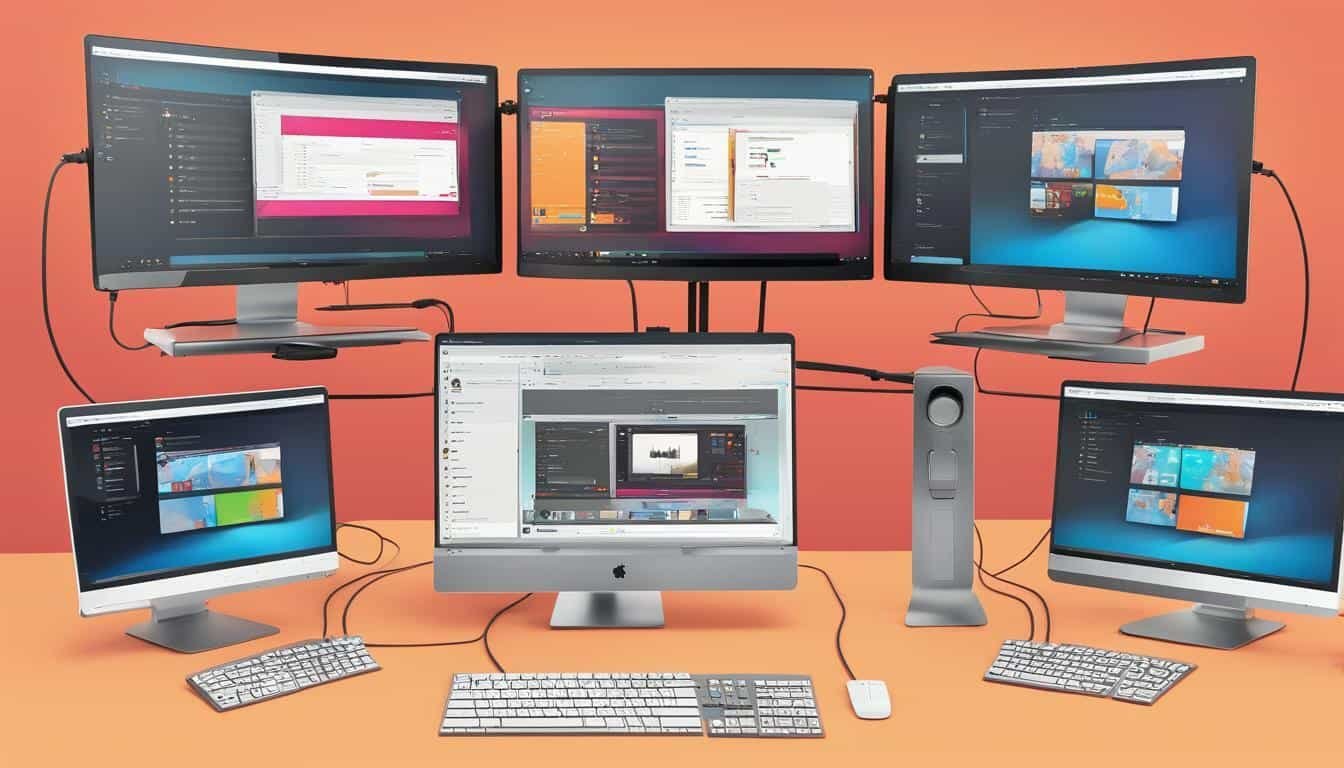As a professional copywriting journalist, I’ve come across many complex technologies. However, KVM switches are not one of them. In this article, I aim to provide a straightforward explanation of KVM switches and their benefits, as well as a guide on how to choose and set them up.
Key Takeaways:
- KVM switches allow users to control multiple computers using a single keyboard, video monitor, and mouse.
- Using a KVM switch can save space, reduce clutter, improve productivity, and simplify workflow.
- When choosing a KVM switch, consider the number of ports, video resolution, and USB compatibility.
- Setting up a KVM switch involves connecting devices, configuring settings, and troubleshooting common issues.
- KVM switches have various applications, from server rooms to home offices.
- KVM switches have advantages over software-based solutions in terms of reliability and security.
Understanding KVM Switches
As mentioned earlier, a KVM switch is a device that allows users to control multiple computers using a single keyboard, video monitor, and mouse. But how exactly does it work? Well, a KVM switch acts as a hub between the computers and the peripherals, allowing the user to switch control from one computer to another.
The KVM switch connects to the computers via cables, which are plugged into the switch’s ports. The peripherals are then connected to the switch using additional cables. When the user wants to control a particular computer, they simply press a button on the switch to switch the control to that computer.
Some KVM switches have additional features, such as the ability to switch between computers automatically or the ability to share USB devices between computers. These advanced features, however, may require additional setup and configuration.
Understanding KVM Switch Modes
There are two main modes for using a KVM switch:
- Hotkey Mode – This mode allows users to switch between computers using pre-defined keyboard shortcuts, such as pressing “Scroll Lock” twice and then the number key for the desired computer. Hotkey mode is generally faster than using the buttons on the switch, but requires memorizing the specific hotkey combinations.
- Manual Mode – This mode requires users to physically press the button on the switch to switch between computers. While it may be slower than hotkey mode, it eliminates the need to memorize hotkeys and is generally more intuitive for new users.
Understanding the mode you prefer to use will help you get the most out of your KVM switch setup.
Benefits of Using a KVM Switch
Using a KVM switch can offer several benefits that can greatly enhance your workspace. Here are some of the key advantages:
| Benefit | Description |
|---|---|
| Space-saving | Using a single keyboard, monitor, and mouse can save physical desktop space, especially when controlling multiple computers. |
| Reduced clutter | With just a single set of peripherals, you can eliminate the clutter and tangled mess of multiple cables and devices. |
| Improved productivity | Switching between multiple computers without physically changing devices saves time and effort, boosting productivity. |
| Simplified workflow | Using a KVM switch can simplify your workflow and help you stay organized, particularly when working with numerous devices. |
Overall, a KVM switch can be an excellent investment for anyone looking to streamline their workspace, save time, and improve productivity.
Choosing the Right KVM Switch
When selecting a KVM switch, it’s important to consider your specific requirements to ensure you choose the right one. Here are some important features to keep in mind:
| Feature | Description |
|---|---|
| Number of Ports | Determine how many devices you need to connect and select a KVM switch with enough ports. It’s always a good idea to choose a switch with extra ports for future expansion. |
| Video Resolution | Ensure that the KVM switch supports the video resolution you require for your display devices. For instance, if you use 4K monitors, choose a switch that can handle that resolution. |
| USB Compatibility | If your devices rely on USB, ensure that the KVM switch is compatible with the USB standard of your peripherals. USB 3.0 and USB-C are popular standards to look for. |
Other factors to consider include the type of connection (e.g. VGA, DVI, HDMI), the physical dimensions of the switch (if you have limited space), and any additional features you may need, such as audio support or remote access capabilities.
Conclusion
By evaluating your specific needs and features important to you, you can choose the right KVM switch to meet your requirements. Be sure to carefully read the product specifications and reviews before making a purchase to ensure you get the most value for your investment.
KVM Switch Setup Guide
Setting up a KVM switch is straightforward and easy to do. Follow these steps to ensure a smooth and hassle-free setup process:
- Power Off: Turn off all computers and the KVM switch before making any connections.
- Connect Devices: Connect all devices to the appropriate ports on the KVM switch.
- Connect KVM: Connect the KVM switch to each computer using the appropriate cables.
- Power On: Turn on all computers and the KVM switch.
Once all the devices and cables are connected, configure the KVM switch settings to ensure optimal performance.
| Settings | Description |
|---|---|
| Hotkey Switching | Assign specific hotkeys to switch between different devices. |
| Auto Scan | Configure the KVM switch to switch between devices automatically after a set period. |
| Mouse Synchronization | Configure the KVM switch to synchronize the mouse settings across all devices. |
If you encounter any problems during the setup process, refer to the troubleshooting section below for solutions.
Troubleshooting KVM Switch Issues
If you’re experiencing issues with your KVM switch, don’t worry – most problems can be easily resolved with a few basic troubleshooting steps. Here are some common issues and how to resolve them:
Mouse and Keyboard Not Responding
If your mouse and keyboard are unresponsive, the first step is to check the cables and connections. Ensure that all cables are connected securely and properly. If the problem persists, try switching the USB ports or plugging them into a different computer to ensure that they are functioning correctly. If the issue persists, try testing another keyboard and mouse to see if they work.
Display Issues
If your display is not working correctly, ensure that the video cables are properly connected and that the monitor is turned on. If you’re still experiencing issues, check the video resolution settings on your computers to ensure that they are compatible with the KVM switch. If you’re using a VGA cable, make sure that the pins are not bent or damaged.
Audio Issues
If you’re experiencing audio problems, make sure that your speakers are properly connected to the KVM switch and that their volume is turned up. Ensure that you’ve selected the correct audio source on your computers. If the issue persists, try connecting your speakers directly to your computer to ensure that they are working correctly.
By following these simple troubleshooting steps, you can quickly and easily resolve most issues you may encounter with your KVM switch.
Expanding the Use of KVM Switches
Using a KVM switch goes beyond controlling multiple computers using a single keyboard and mouse. These versatile devices can be used in different settings, providing enhanced flexibility and improved workflow. Here are some additional ways to leverage KVM switches:
- Server rooms: KVM switches can be used to control multiple servers from a single console, allowing system administrators to manage and troubleshoot their network more efficiently.
- Data centers: KVM switches can help streamline data center operations by consolidating server and network management onto a single platform.
- Home office setups: KVM switches can help users save space and reduce clutter by sharing peripherals between multiple computers, improving productivity and convenience.
Unlocking the Full Potential of KVM Switches
By using KVM switches in these settings, users can unlock their full potential and achieve greater efficiency, flexibility, and control. Whether managing complex global networks or streamlining home office setups, KVM switches offer a simple and effective way to manage multiple devices from a single console.
KVM Switches vs. Software Solutions
While KVM switches offer a reliable hardware-based solution for controlling multiple computers, software-based alternatives are also available.
One major advantage of software solutions is their cost-effectiveness and ease of use. They require no additional hardware, allowing users to access multiple computers from a single interface. Additionally, they usually offer more advanced features, such as remote access and file sharing.
On the other hand, KVM switches are often preferred for their reliability and security. They do not rely on software for functionality, making them less susceptible to viruses and malware. They also do not require an internet connection, providing a more secure environment for sensitive data.
Ultimately, the choice between KVM switches and software solutions depends on the specific needs and preferences of the user. Those who prioritize security and reliability may prefer KVM switches, while those seeking convenience and cost savings may opt for software-based alternatives.
Conclusion
Overall, a KVM switch can provide many benefits for users who need to control multiple computers from a single workstation. By using a KVM switch, users can save space, reduce clutter, and streamline their workflow, leading to increased productivity and efficiency.
When choosing a KVM switch, it is important to carefully consider the specific features and requirements for your setup, such as the number of ports, video resolution, and USB compatibility. Additionally, users should follow the provided setup guide and troubleshoot any issues that may arise.
Expanding the use of KVM switches to server rooms, data centers, and home office setups can also provide additional benefits. However, it is important to weigh the pros and cons of KVM switches compared to software-based alternatives before making a decision.
Overall, a KVM switch is a valuable tool for anyone who needs to control multiple computers from a single workstation. By following the guidelines and tips outlined in this article, users can make the most of their KVM switch and experience seamless control over their devices.
What are the Basic Steps for Using a KVM Switch?
Using a KVM switch allows easy toggling between multiple computers using a single setup. To get started, connect your computers to the switch using VGA, USB, and audio cables. Next, connect your keyboard, mouse, and monitor to the KVM switch. Finally, use the switch’s hotkey commands or physical buttons to effortlessly switch between computers. This easy guide to kvm switches simplifies multitasking and enhances productivity.
FAQ
Q: What is a KVM switch?
A: A KVM switch is a device that allows you to control multiple computers using a single set of keyboard, video monitor, and mouse.
Q: How does a KVM switch work?
A: A KVM switch works by connecting all the computers to the switch and then connecting the switch to the keyboard, video monitor, and mouse. The user can then switch between computers by pressing a hotkey or using a button on the switch.
Q: What are the benefits of using a KVM switch?
A: There are several benefits of using a KVM switch, including saving space by reducing the number of keyboards, video monitors, and mice needed, reducing clutter on your desk, improving productivity by allowing you to switch between computers quickly, and simplifying your workflow.
Q: How do I choose the right KVM switch?
A: To choose the right KVM switch, you need to consider your specific requirements. This includes the number of computers you want to connect, the video resolution you need, and the compatibility with USB devices. You should also consider future expansion needs.
Q: How do I set up a KVM switch?
A: Setting up a KVM switch involves connecting the computers to the switch using the appropriate cables, connecting the switch to the keyboard, video monitor, and mouse, and configuring any necessary settings. If you encounter any issues, you can refer to the troubleshooting section for help.
Q: What should I do if I encounter issues with my KVM switch?
A: If you encounter issues with your KVM switch, you can try troubleshooting steps such as checking cable connections, restarting the switch and computers, and updating firmware or drivers. If the problem persists, you can refer to the troubleshooting section for more detailed solutions.
Q: Can a KVM switch be used in server rooms or data centers?
A: Yes, KVM switches are commonly used in server rooms and data centers to manage multiple servers efficiently. They allow administrators to control and monitor servers from a single location, reducing the need for multiple keyboards, video monitors, and mice.
Q: How does a KVM switch compare to software-based solutions?
A: A KVM switch provides a hardware-based solution for controlling multiple computers, while software-based solutions typically require installation and configuration on each computer. KVM switches offer more reliable and secure control, but software-based solutions can be more cost-effective for smaller setups.

![Top & Best Processors For Hacking: [High-Performance CPUs]](https://nondevelopers.com/wp-content/uploads/2023/06/Best-Processors-for-hacking.jpg)


0 Comments